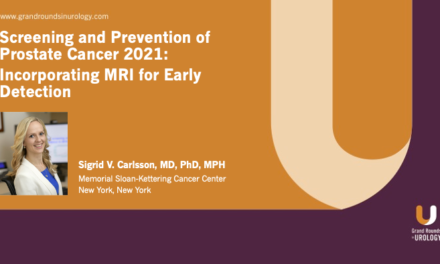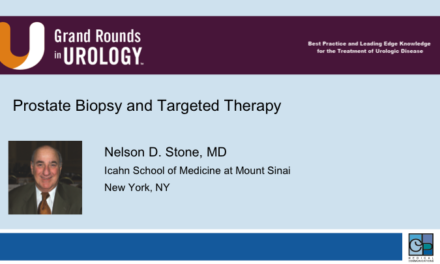Clare Tempany, MD, presented “Current and Emerging Imaging Tools for Improving Risk Assessment and Selection of Patients for Biopsy” during the Virtual Global Summit on Precision Diagnosis and Treatment of Prostate Cancer in October 2020.
How to cite: Tempany, Clare. “Current and Emerging Imaging Tools for Improving Risk Assessment and Selection of Patients for Biopsy.” October 2020. Accessed Jan 2025. https://dev.grandroundsinurology.com/current-and-emerging-imaging-tools-for-improving-risk-assessment-and-selection-of-patients-for-biopsy/
Current and Emerging Imaging Tools for Improving Risk Assessment and Selection of Patients for Biopsy – Summary
Clare Tempany, MD, the Ferenc A. Jolesz Professor of Radiology at Harvard Medical School in Boston, Massachusetts, summarizes evidence for multiparametric magnetic resonance imaging’s (mpMRI) utility in prostate cancer diagnosis, and goes over recent developments in its use. She first looks at selection criteria for biopsy and biopsy type, including history, digital rectal examination (DRE), prostate specific antigen (PSA), and imaging, arguing that mpMRI is particularly helpful in allowing patients to avoid unnecessary biopsies. Dr. Tempany then defines state-of-the art mpMRI as featuring diffusion/apparent diffusion coefficient, being T2-weighted, being IV contrast/dynamic contrast enhanced, and as being reported using the PI-RADS v2.1 assessment. She goes over the PI-RADS assessment categories, considers the findings of multiple publications backing up the value of mpMRI as compared to transurethral ultrasound (TRUS), and looks at evidence supporting guidance indicating patients with PI-RADS 3 lesions should get a biopsy. Dr. Tempany follows this up by summarizing a paper from the PI-RADS steering committee on how PI-RADS and mpMRI should be used. Suggestions include performing mpMRI in most men suspected of having clinically-significant disease, providing a safety net of monitoring for patients who decline immediate biopsy after low-likelihood MRI findings, and using a combination of systematic and targeted biopsies in biopsy-naive patients while only using targeted biopsies for patients with prior negative findings on TRUS. Dr. Tempany then notes that the AUA, EAU, and NICE guidelines all now recommend MRI before biopsy, and also observes that MRI is cost-effective if it leads to the avoidance of biopsy. She concludes by listing areas for future development, including multi-omics, molecular pathology, germline mutations, CTC/blood biomarkers, and mass spectrometry.
The Virtual Global Summit on Precision Diagnosis and Treatment of Prostate Cancer brings together key international opinion leaders of every clinical subspecialty involved in patient care. This event is an integral part of the AdMeTech Foundation’s Annual Summit, which was established in 2016 and become seminal in shaping the state of the art and future vision for precision care. The goal of this event is three-fold: 1) Educating the key stakeholders; 2) Supporting a sustained cross-disciplinary dialogue and consensus on the best emerging clinical practices and research priorities; and 3) Expediting clinical adoption of promising novel diagnostics and therapeutics. For more educational activities from this virtual event, visit our collection page.
ABOUT THE AUTHOR
Dr. Tempany is the Ferenc A. Jolesz Professor of Radiology at Harvard Medical School in Boston, Massachusetts. She also serves as Vice Chair of Radiology Research and Medical Director of the Advanced Multi-modal Image Guided Operating (AMIGO) Suite, a suite of translational clinical research rooms at Brigham & Women’s Hospital in Boston. Dr. Tempany is a native of Dublin, Ireland, and a graduate of the Royal College of Surgeons in Ireland. She completed her internship and a senior house officer program in internal medicine in Dublin prior to moving to Chicago for residency training in Diagnostic Radiology at Loyola University of Chicago. She went on to a fellowship and her first faculty appointment in MRI at Johns Hopkins Medical Institutions in Baltimore, Maryland. Three years later, she moved to Brigham & Women’s Hospital to join the Abdominal Imaging Division.
Dr. Tempany established the Body MRI Program at Brigham & Women’s Hospital with a pioneering focus on prostate and gynecological imaging. Then, through a unique partnership with Anthony D’Amico, MD, she helped establish the first ever MR-guided prostate cancer brachytherapy program in 1997. She followed this by partnering with Noby Hata, PhD, to establish the first MR-guided transperineal in-bore prostate cancer biopsy program. Now, 20 years later, both MR-guided prostate cancer biopsy and MR-guided radiation therapy are rapidly becoming the standard of care to aid in prostate cancer diagnosis and treatment.
Today, Dr. Tempany leads trials in mpMRI, is Co-Chair of the PI-RADS international committee, is the PI of a InSightec-sponsored focal therapy trial with MR-guided FUS, and is study chair of the new ECOG-ACRIN trial in prostate MRI. She has had continuous NIH funding for over 20 years and is currently the PI of the NIH funded-P41, and a T32 training grant in image-guided therapy.





